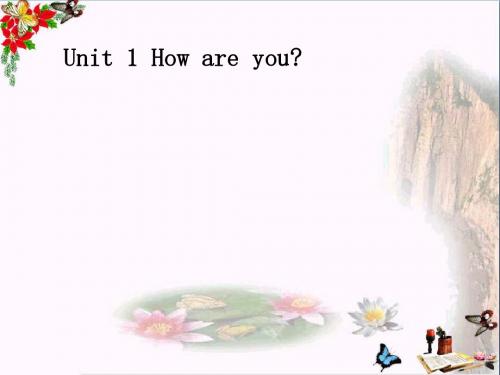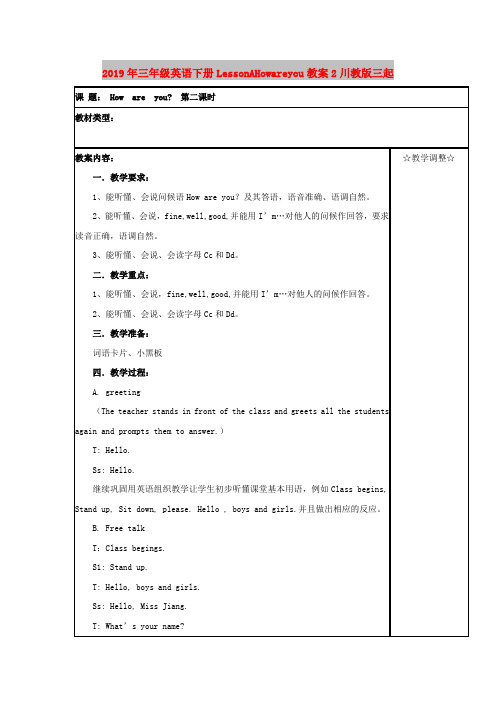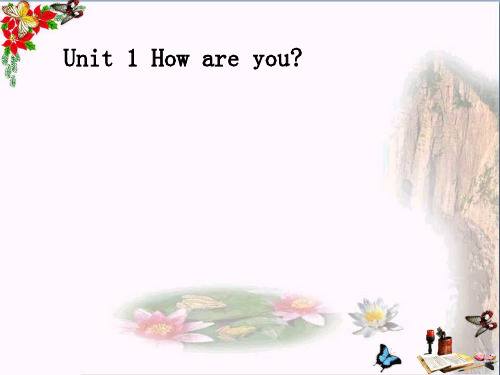三年级英语下册LessonAHowareyou教案2川教版三
- 格式:doc
- 大小:36.00 KB
- 文档页数:3

IntroductionEnglish is a universal language that is spoken globally, and it is the language of international communication. Being able to communicate in English is an important skill for anyone who wishesto work, travel or study abroad. In this lesson, we will focus on an essential aspect of English communication, which is greeting; in particular, we will focus on how to use the greeting phrase "how are you" when meeting and greeting people from different cultures and backgrounds.ObjectivesBy the end of this lesson, students will be able to:1.Understand the importance of greeting people in English.2.Learn common greetings in English.3.Understand how to use the phrase "how are you?" in differentcontexts and cultures.4.Understand cultural differences in greetings between differentcountries.Materials-Whiteboard and markers-Handouts with common English greetings-Images of people greeting each other from different cultures-Audio and video clips of people using various greetingsProcedure1.Introduction (5 minutes)Begin the lesson by eliciting from the students why learning how to greet people in English is essential. Ask them to discuss in pairs and share their thoughts with the class, then write down some of the reasons they come up with on the board.mon English Greetings (10 minutes)Provide the students with a handout featuring common English greetings, such as "hello," "good morning," "good afternoon," "good evening," and "how are you." Have them work in pairs to practice these greetings together.3.Understanding the Phrase "How are you?" (10 minutes)Explain to the students that "how are you" is the common English greeting that people use when they meet each other. But often, it is not meant to be taken literally. People use it more as a polite greeting rather than as a request for detailed information aboutone's well-being. Demonstrate with examples how people might respond to this question based on the context and relationship between the speakers.4.Cultural Differences in Greetings (20 minutes)Provide the students with images and videos of people greeting each other from different cultures, and discuss these differences withthe students. Encourage the students to consider how these cultural differences may impact the way people interpret and respond to greetings.5.Role-Playing Exercises (15 minutes)Assign the students to groups and have them practice greeting each other using "how are you?" in various contexts, such as meeting friends, meeting strangers, and meeting in a formal setting. Encourage the use of body language and nonverbal communication to convey the appropriate tone and meaning.6.Conclusion (5 minutes)In conclusion, summarize the key points of the lesson and ask the students to reflect on what they have learned. Have them share their thoughts with the class and provide feedback on the lesson.ConclusionIn today's globalized world, the ability to communicate in Englishis more critical than ever. Greeting people in English is anessential part of successful communication, and using theappropriate greeting in diverse contexts is crucial to building relationships and understanding different cultures. By learning how to use the greeting phrase "how are you," students will be able to greet people with confidence and respect, regardless of theircultural background or native language.。


三年级how are you教案一、教学目标。
1. 语言知识目标。
学生能够听、说、认读单词“fine, thank, you”。
学生能够理解并运用句型“How are you? I'm fine, thank you.”进行简单的问候交流。
2. 语言技能目标。
通过听、说练习,提高学生的听力和口语表达能力。
培养学生在实际情境中运用英语进行问候的能力。
3. 情感态度目标。
激发学生学习英语的兴趣,培养积极参与课堂活动的态度。
引导学生养成用英语礼貌问候他人的习惯。
二、教学重难点。
1. 教学重点。
掌握重点单词“fine, thank, you”的发音和意义。
熟练运用句型“How are you? I'm fine, thank you.”进行对话。
2. 教学难点。
使学生能够在不同情境中自然、流利地运用句型进行问候。
让学生理解“thank you”的正确语用功能。
三、教学方法。
1. 情景教学法。
通过创设真实的问候情景,帮助学生理解和运用所学的英语知识。
2. 游戏教学法。
利用游戏激发学生的学习兴趣,提高课堂参与度。
四、教学过程。
1. 导入(3分钟)师生问候。
T: Good morning/afternoon, boys and girls.Ss: Good morning/afternoon, Miss/Mr...教师引导学生观察自己的表情,并提问“How do I look today?”引导学生用简单的形容词回答,如“happy”“sad”等,从而引出本节课的话题——问候他人的身体状况。
2. 新授(12分钟)呈现单词。
教师通过展示自己健康、精神的状态,说“I'm fine today.”,并板书“fine”,教读几遍,让学生跟读,注意纠正发音。
教师说“I'm fine, thank you.”,板书“thank, you”,一个一个教读单词,强调“thank”中“th”的发音。


小学英语新课程标准教材英语教案( 2019 — 2020学年度第二学期 )学校:年级:任课教师:英语教案 / 小学英语 / 小学三年级英语教案编订:XX文讯教育机构Lesson 3 How are you(教案)教材简介:本教材主要用途为通过学习英语的内容,提高学生的语言技能,增加一项语言能力,有利于国际化的日常交流、生活、工作等,本教学设计资料适用于小学三年级英语科目, 学习后学生能得到全面的发展和提高。
本内容是按照教材的内容进行的编写,可以放心修改调整或直接进行教学使用。
lesson 3 how are you第一课时教学目标:1.能够熟练掌握字母hh, ii, jj, kk的读音以及大小写的书写形式;并且要注意ii的读音,aa, hh, jj, kk的共同读音,小写k的书写以及字母h, i, j, k在单词中的读音.2.能够听说,认读并应用单词: hand, bike, jeep, key.教学重点,难点重点:字母hh, ii, jj, kk的读音与书写难点:ii的读音,aa, hh, jj, kk的共同读音,小写k的书写以及字母h, i, j, k在单词中的读音.课前准备:教师准备hh, ii, jj, kk四组字母的大小写卡片.教师准备hand, bike, jeep, key的教学图片各一张,小夹子两个.教学过程1.复习唱歌曲what's your name用接龙问答的形式复习第二课对话,介绍自己姓名,询问对方姓名并告别2. 新课展示(new presentation)教师通过课前准备好的字母卡片以及相关单词的图片或者其他教具来讲解句型和词汇:1)教师出示字母卡片进行字母规范书写的教学.这一部分教师讲解各个字母的读音及书写细则,给学生看书写体和印刷体的卡片,帮助学生分析书写格式:大写字母h占上两格,上不顶格,三笔写成,先写两竖,再写短横;小写字母h 占上两格,上不顶格,一笔写成.以同样的方式教学ii, jj, kk, 强调aa, hh, jj, kk都含有aa的读音,字母ii则含双元音/ai/,发音时口张大,不能读成/ei/.强调书写体小写字母i和j 先写下面的竖,后写上面的点,小写字母k一笔写成.2)教师通过课前准备好的单词卡片或者实物进行单词教学.hand: /h nd/, 其中字母h发/h/的音,清辅音/h/发音时气流从两条声带间的缝隙(声门)通过,摩擦声门而成.bike: /baik/, 其中i发/ai/的音,发音时由/a/滑动到/i/,滑动距离大,是宽双元音;结尾字母e不发音.jeep: /d i:p/, 其中浊辅音/d /发音时舌端先顶在上齿龈后部,不留缝隙,然后渐渐放开,气流缓缓地从缝隙中冲出.key: / /, 其中浊辅音/k/发音时舌后部隆起,气流从喉咙口用力冲出来,发出爆破音.3.巩固活动:(小组游戏)1)让学生打开书,放第一,二部分录音,让学生先听后跟读2) 字母游戏.将所学字母卡片中的一张藏起来,把其余卡片给学生看,让学生观察那张字母卡片被藏起来了.3)单词练习4.课后作业(homework):1)《课堂练习》第1题:听录音,圈出你所听到的字母.2)《课堂练习》笔写部分1—5第二课时教学目标:1.能熟练掌握对话,并会用该句型:how are you i'm fine, thank you. and you i'm fine,too.进行问答操练,能在不同场合正确地运用不同的问候语.2.能听懂,认读单词how, are, you, i'm, i, am, fine, thank, too, mr.教学重点,难点重点:—how are you—i'm fine, thank you.难点:能在不同的场合正确的运用不同的问候语课前准备:教学挂图,录音机,单词图片教学过程1.复习检查《课堂练习》上的作业复习字母aa,bb,ccdd, ee, ff, gghh, ii, jj, kk.老师出示卡片,让学生很快认读并找出相应的大小写字母卡片看图片复习单词cake, bag, pencil dog, sheep, fish, giraffe hand, bike, jeep, key,叫学生个别人读后让全班认读给出情景让学生自由对话2.介绍新对话教师要给学生说明当我们想要表达"你好吗 "的意思时,我们可以使用"how are you "句型,并学会使用i'm fine.来回答.但是在此教师要注意给学生强调how are you 是用于熟人之间有一段时间没有见面,或是对方身体欠佳,或是较为正式地向别人打招呼等场合.因此,要告诉学生, 不是每次见面都必须问此话.每天见面时,只要说hello/hi!就行了.接下来,教师可以通过以下儿歌和学生进行训练,巩固和复习:how are youhello! hello! hello!how are youi'm fine. i'm fine.hello! how are you3. 练习巩固1)看图练习,读课本中的对话,学生同桌两人练习对话2) 问答接力本部分教师可以安排学生以一数列为单位,进行从前到后,或者从后到前的问答游戏,看看哪个组问得快,答得准确.速度快且正确的为胜方.具体操作如下:第一个同学向后转身问第二个同学how are you 第二个同学迅速回答i'm fine. thank you, and you 第一个同学回答说i'm fine, too.之后,第二个同学再去问后面第三个同学,以此类推.4.课后作业1)听读第三课三遍2)《课堂练习》笔写部分第三题:看图口头完成对话3)两人一组互相进行问候,致谢,道别.XX文讯教育机构WenXun Educational Institution。

Lesson 2:How Are You?学习目标 :1.能听懂、会说、会读句型:How are you? Fine,thanks.2.通过同伴练习掌握What’s your name ? My name is _______.的问答3、培养良好的学习习惯.重点:句型的正确问答难点:将句型灵活运用于情景中[预习自测]预习方法建议:迅速阅读,把握打招呼及问候的简单用语。
一、写出下列单词及句子的汉语意思。
hello/hi__________name________ teacher__________new_________ thanks_________Nice to meet you.__________________.My name is Jenny._________________.What's your name?__________________?Howareyou?____________?Fine,thanks._________________.二、小组之内做对话(打招呼、问好)。
三、说一说在预习过程中你的收获和疑问。
——————————————————————————【合作交流】11.小组内认真、仔细地朗读课文内容2.疑惑整理:一:ready准备Are you ready for school? 你准备好上学了吗?二:call称呼,叫You can call me Mr.Wood!先生伍德三:G reat! 太好了,棒极了!3.学以致用,拓展提升情景小剧:同学扮演老师与同学进行小对话并展示交流。
【当堂检测】选择正确的答案。
1.———Nice to meet you.———_______________A.My name is Jenny.B.Nice to meet you,too!2.——How are you?——______________A.Fine,thanks.How are you?B.What's your name?3.You can _____me Mr. Wood.A.readyB.call我的收获与感悟:————————————————————2。
小学英语学习材料金戈铁骑整理制作课题:How are you? 第二课时教材类型:教案内容:☆教学调整☆一.教学要求:1、能听懂、会说问候语How are you?及其答语,语音准确、语调自然。
2、能听懂、会说,fine,well,good,并能用I’m…对他人的问候作回答,要求读音正确,语调自然。
3、能听懂、会说、会读字母Cc和Dd。
二.教学重点:1、能听懂、会说,fine,well,good,并能用I’m…对他人的问候作回答。
2、能听懂、会说、会读字母Cc和Dd。
三.教学准备:词语卡片、小黑板四.教学过程:A. greeting(The teacher stands in front of the class and greets all the students againand prompts them to answer.)T: Hello.Ss: Hello.继续巩固用英语组织教学让学生初步听懂课堂基本用语,例如Classbegins, Stand up, Sit down, please. Hello , boys and girls.并且做出相应的反应。
B. Free talkT:Class begings.S1: Stand up.T: Hello, boys and girls.Ss: Hello, Miss Jiang.T: What’s your name?S1: Hello, my name is ….T:How are you?S1:I’m fine, thank you.开起小火车。
C、Look and learn1)带领学生读准每个单词。
2)可以利用所做的动物头饰,结合A部分的教学内容,进行多种应答,如:T:Hello, Miss Dog. How are you?S: I’m fine, thank you. / I’m well, thank you. / I’m good, thank you.3) 利用课堂实际情景,鼓励学生用本部分新出现的教学内容进行灵活地应答。